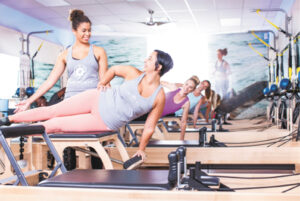By Shannon Willits, Master Pilates Educator
 Every November, American Diabetes Month reminds us that health is not static. It is something we constantly balance, one mindful choice at a time. According to the CDC, more than one in ten Americans live with diabetes, and over ninety-six million adults have prediabetes without knowing it. That is nearly half the adult population hovering at a metabolic crossroads, where small, daily decisions determine whether we restore balance or drift further from it.
Every November, American Diabetes Month reminds us that health is not static. It is something we constantly balance, one mindful choice at a time. According to the CDC, more than one in ten Americans live with diabetes, and over ninety-six million adults have prediabetes without knowing it. That is nearly half the adult population hovering at a metabolic crossroads, where small, daily decisions determine whether we restore balance or drift further from it.
When people think about managing blood sugar, the conversation usually begins with diet. And while nutrition is essential, movement is an equally powerful form of medicine when practiced consistently, intelligently, and with intention. Pilates provides the missing link between movement and metabolic health, offering a method that builds strength, quiets stress, and restores the body’s natural rhythm of balance.
The Science of Movement and Metabolism
At its core, Pilates is a resistance-based, mindful movement system that develops lean muscle, enhances joint mobility, and regulates the nervous system—the trifecta for supporting glucose control. Each time a muscle contracts, it pulls glucose from the bloodstream for fuel. Think of it as nature’s own prescription for lowering blood sugar, one repetition at a time. Studies show that resistance training can improve insulin sensitivity for up to forty-eight hours after a single session, meaning muscles remain more responsive to insulin and require less of it to keep blood sugar steady.
What makes Pilates unique is its precision and control. Rather than pushing the body into exhaustion, Pilates builds capacity through alignment, awareness, and breath. The result is strength without stress and a workout that conditions the nervous system as much as the muscles, leaving the body balanced rather than depleted.
Building Muscle Without Burning Out
Effective diabetes management depends as much on calming the body’s stress chemistry as it does on improving metabolism. When cortisol, the body’s primary stress hormone, stays elevated, it interferes with insulin’s ability to move glucose into the cells. The result is a double burden: higher blood sugar and greater fat storage around the midsection.
Pilates helps reverse this process by teaching the body to pair movement with calm rather than tension. Through precise breathing and controlled engagement, it moderates the hormonal response that drives inflammation and glucose imbalance. Every mindful session delivers a clear message through the nervous system: the body is safe. In that safety, muscles respond more efficiently, circulation improves, and metabolism begins to restore its natural rhythm.
Rather than driving the body into fatigue, Pilates builds endurance through precision, breath, and mindful control. It cultivates metabolic resilience, allowing the body to adapt, recover, and maintain steady energy.
Mobility: The Forgotten Metabolic Marker
One of the silent risk factors for diabetes is immobility. When movement becomes uncomfortable or painful, people move less, circulation slows, and insulin resistance quietly worsens. Pilates helps bridge that gap by restoring ease to the joints and suppleness to the spine, hips, and shoulders. Healthy movement does not have to be extreme; it simply has to be sustainable. When the body feels capable, movement becomes natural again, keeping circulation, digestion, and metabolism active.
Emerging research from the American Diabetes Association and Harvard Medical School highlights that circulation, muscle elasticity, and movement quality directly influence glucose control. When the body moves with ease, blood flow improves, inflammation decreases, and glucose is delivered to the muscles more efficiently. The result is a steadier energy state and a metabolism that functions with greater balance and precision.
Strength from the Inside Out
Muscle tissue is the body’s largest storage site for glucose, making it essential for blood sugar regulation. Adults lose an average of three to eight percent of their muscle mass each decade after age thirty, a gradual decline known as sarcopenia. Pilates helps preserve and rebuild this vital tissue by training the deep stabilizers and postural muscles in harmony. Unlike traditional weightlifting, it layers precision and eccentric control to build strength without joint strain, creating power that is both functional and sustainable.
Equally important, Pilates addresses the mental and emotional weight of living with a chronic condition. Diabetes can bring a constant sense of vigilance and fatigue, but mindful movement offers a way to release that tension. Each breath becomes a form of self-regulation, calming the nervous system and restoring internal balance. As breath steadies, so does blood sugar, and with time, confidence replaces fear as the body begins to trust itself again.
The Takeaway: Movement as Preventive Medicine
The future of healthcare is shifting toward integration, where movement, mindfulness, and metabolic science work together. Pilates fits naturally within that evolution. It is not about perfection but about improving communication within the body, between breath and muscle, effort and ease, glucose and insulin.
For those living with or at risk for diabetes, the goal is not to push harder but to move smarter. Pilates teaches how to stabilize from the center, breathe efficiently, and build strength that supports rather than depletes.
Health, like movement, is dynamic. It is not a finish line but an ongoing conversation. Every mindful repetition reminds the body how to restore balance. The smallest, most intentional movements often create the most lasting change, each one an act of repair.
Shannon Willits, Master Pilates Educator
Shannon Willits is a Master Pilates Educator with over 20 years of experience in functional movement and athletic performance. She is STOTT-certified, a Fellow of Applied Functional Science (FAFS), and a Functional Golf Specialist, bringing expertise to both rehabilitation and sport-specific training. As the owner of four Club Pilates studios in Lee County, FL, she trains and mentors aspiring instructors through her Southwest Florida Pilates Academy and inno- vative apprenticeship model. Shannon is also the host of the Alignment Matters Podcast, where she shares insights on Pilates, movement science, and wellness. ay be the wisest health decision they make.









